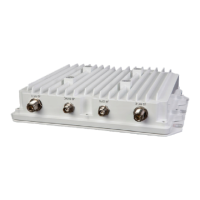3-16
RF-7800W
SYSTEM ADMINISTRATION AND CONFIGURATION
3.8.7 Antenna Alignment
The radio provides aids to aligning the antenna to a remote radio. Radios can be configured to emit a chirping sound
(referred to as a buzzer) that chirps faster with higher average Receive Signal Strength Indication (RSSI). The radio
GUI also contains a page that refreshes every second and displays the RSSI and Signal-to-Noise and Distortion Ratio
(SINADR) for the link.
This aid is not available on a SPMP SC if more than one link
is present.
3.8.8 Security
Security settings are described below. All parameters for Security can only be accessed using GUI and CLI
interfaces.
3.8.8.1 Encryption Type
The radio supports AES encryption of all user and management data sent over the air. AES is implemented and
available in both 128-bit and 256-bit block lengths.
3.8.8.2 Shared Secret
AES encryption uses a key that is derived from a pre-shared secret. The secret must be between 32 and 64
alphanumeric characters.
3.8.8.3 Shared Secret Hash
A convenient and secure method of ruling out mismatched shared secrets is to compare a truncated, one-way hash
of the shared secret. If shared secrets have been entered properly on both sides of a radio link, the shared secret
hashes will be identical.
3.8.8.4 X.509 Authentication
An additional method of security is implemented that uses X.509 certificates to authenticate the radios that are
configured to link over the air. The radio authenticates the certificate of its link partner before finishing the link-up
process. X.509 Authentication may be purchased separately as part of Traffic Flow Security. Refer to Paragraph 5.6.
3.8.8.5 SC MAC Address
The MAC address of an SC can be used to restrict a radio configured for SS operation to only link with that SC. To
link with any valid SC, the default value 00:00:00:00:00:00 should be used.
3.8.9 ATPC
ATPC stands for Automatic Transmit Power Control and is useful for reducing co-site interference or dealing with
dynamically changing link conditions. A target RSSI is set on the SC radio, which is used as the goal for all radio
links. If link conditions are degraded and the current transmit power is lower than the maximum configured transmit

